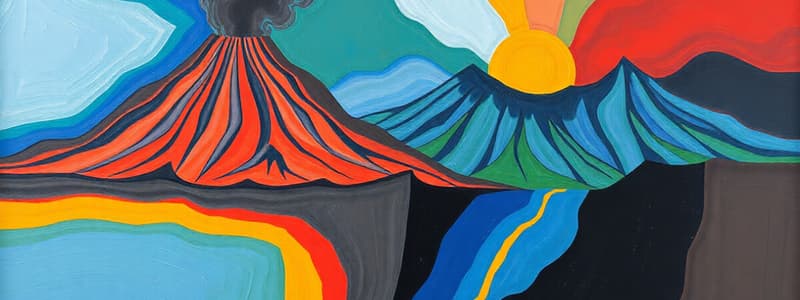Podcast
Questions and Answers
Which of the following statements best explains the observed correlation between the location of active volcanoes, earthquake epicenters, and major mountain belts?
Which of the following statements best explains the observed correlation between the location of active volcanoes, earthquake epicenters, and major mountain belts?
- They are primarily concentrated along plate boundaries due to the interactions and movements of tectonic plates. (correct)
- They are all caused by meteor impacts.
- They are formed independently of each other due to localized geological processes.
- They are randomly distributed across the Earth's surface due to varying geothermal activity.
A region is experiencing frequent earthquakes, and geologists discover a chain of volcanoes nearby. Based on the Plate Tectonic Theory, what is the most likely explanation for these events?
A region is experiencing frequent earthquakes, and geologists discover a chain of volcanoes nearby. Based on the Plate Tectonic Theory, what is the most likely explanation for these events?
- The region is situated at a convergent boundary where one plate is subducting under another. (correct)
- The region is experiencing post-glacial rebound, causing both seismic and volcanic activity.
- The region is undergoing isostatic adjustment due to sediment deposition.
- The region is located near a transform fault boundary where plates slide past each other horizontally.
Scientists observe that the Andes Mountains, a major mountain belt, are located along the western coast of South America, which is also a region with frequent earthquakes and active volcanoes. Which plate boundary interaction is most likely responsible for this distribution of geological features?
Scientists observe that the Andes Mountains, a major mountain belt, are located along the western coast of South America, which is also a region with frequent earthquakes and active volcanoes. Which plate boundary interaction is most likely responsible for this distribution of geological features?
- A convergent boundary where an oceanic plate is subducting beneath a continental plate. (correct)
- A hotspot where magma plumes are rising from the mantle.
- A transform boundary where two plates are sliding past each other.
- A divergent boundary where two plates are moving apart.
If a map shows a linear chain of volcanoes in the middle of an oceanic plate, away from any plate boundary, which of the following is the most probable cause of this volcanic activity?
If a map shows a linear chain of volcanoes in the middle of an oceanic plate, away from any plate boundary, which of the following is the most probable cause of this volcanic activity?
A seismograph network detects an increasing number of earthquakes along a specific fault line. Simultaneously, satellite data indicates a measurable uplift in the surrounding land. How would you relate these observations to Plate Tectonic Theory?
A seismograph network detects an increasing number of earthquakes along a specific fault line. Simultaneously, satellite data indicates a measurable uplift in the surrounding land. How would you relate these observations to Plate Tectonic Theory?
Flashcards
Plate Tectonic Theory
Plate Tectonic Theory
The theory that Earth's outer layer is divided into several plates that glide over the mantle, the rocky inner layer above the core.
Plate Boundaries
Plate Boundaries
Areas where tectonic plates meet, causing geological events.
Earthquake Epicenters
Earthquake Epicenters
Points on Earth's surface directly above the focus of an earthquake.
Distribution of Active Volcanoes
Distribution of Active Volcanoes
Signup and view all the flashcards
Major Mountain Belts
Major Mountain Belts
Signup and view all the flashcards
Study Notes
- Plate Tectonic Theory explains the distribution of active volcanoes, earthquake epicenters, and major mountain belts.
- The theory is a unifying concept in geology.
- These geological features are primarily located at or near the boundaries of Earth's tectonic plates.
Plate Boundaries and Geological Activity
- Divergent boundaries: Plates move apart, leading to the upwelling of magma from the mantle to create new crust.
- This process causes volcanic activity and the formation of mid-ocean ridges, such as the Mid-Atlantic Ridge.
- Convergent boundaries: Plates collide, with one plate often subducting beneath another.
- Subduction zones are associated with deep-sea trenches, volcanic arcs (e.g., the Andes Mountains, the Ring of Fire), and intense earthquake activity.
- Continental collision zones: Two continental plates collide, resulting in the formation of major mountain belts (e.g., the Himalayas).
- Transform boundaries: Plates slide horizontally past each other, generating frequent earthquakes along fault lines, such as the San Andreas Fault.
Active Volcanoes
- Most active volcanoes are found along the Ring of Fire, a major area in the basin of the Pacific Ocean.
- The Ring of Fire is associated with subduction zones.
- Volcanoes also occur at hotspots, such as Hawaii, which are not directly related to plate boundaries but caused by mantle plumes.
Earthquake Epicenters
- Earthquake epicenters are concentrated along plate boundaries.
- Shallow earthquakes typically occur at divergent and transform boundaries.
- Deep earthquakes are associated with subduction zones.
- The depth of earthquakes at subduction zones provides evidence for the angle and depth of the subducting plate.
Major Mountain Belts
- Major mountain belts, like the Himalayas and the Andes, are formed at convergent plate boundaries.
- The Himalayas formed from the collision of the Indian and Eurasian plates.
- The Andes formed from the subduction of the Nazca Plate under the South American Plate.
Plate Tectonic Theory
- The Plate Tectonic Theory explains that Earth's lithosphere is divided into several large and small plates that are constantly moving.
- The movement of these plates is driven by convection currents in the mantle.
- The interaction of these plates at their boundaries results in various geological phenomena.
Studying That Suits You
Use AI to generate personalized quizzes and flashcards to suit your learning preferences.



